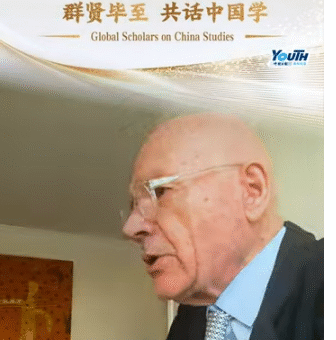From the channel: Glazyev for Thinking People – Chinese Economy
These are a couple of short postings of other writers on Sergei Glazyev’s Telegram channel, translated by translator Maxwell Scott and kindly provided to us by a supporter.
Note what the first one says about Large Language Models in AI. They are probably more widespread than is assumed. The comment at the end of the first one comparing |China’s approach and that of Musk is not saying that they are acting in concert. It is simply that these two more successful approaches are similar.
Glazyev for Thinking People, forwarded from Little Known Interesting, 24 Jan 2025:
The featured image is a diagram of inter-penetrating techno-industrial ecosystems.
China’s main strength is the interpenetrating techno-industrial ecosystems. Why did China not follow the path of Google, Apple or Facebook, but chose a path similar to Elon Musk’s Tesla/xAI?
In the tale of the Kibalchish Boy, the “bourgeoisie” subjected him to terrible torments, eliciting a great Military Secret — a secret that helps his people win. If this happened to a Chinese boy caught by the “bourgeoisie” today, the “great military secret” would be about the secrets of “industrial coevolution” and “techno-industrial convergence.”
One of the key factors in China’s development into the world’s No. 2 superpower with the ambitions of Article No. 1 is China’s unique industrial and technological development strategy. There is nothing special about this strategy that distinguishes China from the United States and other developed countries of the world. This feature is fixed in the emphasis on interpenetrating techno-industrial ecosystems, the landscapes of which you can see in the diagram from the most interesting analytical essay (https://www.high-capacity.com/p/chinas-overlapping-tech-industrial ) of Kyle Chan.
As can be seen from the diagram, China has developed several techno-industrial ecosystems that overlap across the firms involved and frontier technologies. The unique effectiveness of such interpenetrating techno-industrial ecosystems in a multitude of mutually reinforcing positive feedback loops, where progress in one industry strengthens China’s position in others.
The basis of this approach is • “Industrial coevolution” — when two or more related industries develop together in an iterative, two-way process; • and “techno-industrial convergence” — when technologies and product categories that were previously considered unrelated (e.g. phones and cars) are increasingly integrated into their underlying hardware and software, such as smartphones and electric vehicles or even autonomous vehicles. It turns out to be one piece of software, digital platforms, and AI systems capable of processing huge amounts of data and quickly turning it into actions. In terms of hardware, you have a convergence of interconnected technologies, including lithium batteries, electric motors, cameras and sensors, wireless communications, and semiconductor chips.
As a result, Chinese technology companies are increasingly becoming Swiss army knives, starting out in one industry but then rapidly expanding into a number of related technological fields.: smartphones, electric vehicles, autonomous vehicles, generative AI, drones, robotics.
You have: • Smartphone manufacturers (such as Xiaomi) moving into electric vehicles; • * Drone manufacturers (such as DJI), emerging leaders; • Electric vehicle manufacturers (such as BYD) transitioning to semiconductors, or (like Li Auto) transitioning to android robots; • Traditional internet companies (such as Baidu) moving into autonomous vehicles; • and, of course, there is the main Chinese universal technologist, who is at the center of many of China’s tech-industrial ambitions.: Huawei (declared the main enemy of the “bourgeoisie”)
N.B. It is important to note that for the same reason, it is difficult to find a Chinese technology or electronics company today that does not have its own advanced large language model.
This strategy of progress chosen by China by stimulating technology-based ecosystems is fundamentally different from the development model of leading US corporations such as Google, Apple or Facebook. But it strongly resembles the Tesla/xAI strategy of Elon Musk. And perhaps it is this strategic proximity that underlies the far-reaching plans of China and Musk to build something like a global technology ecosystem. [end.]
Glazyev for Thinking People, forwarded from Boris Titov, 24 Jan 2025:
Some say that China’s economy has “sagged.” I mean, it didn’t grow as fast as the Communist Party had planned – and this, they say, is a loud bell about impending problems. That’s the whole question: who’s talking.
Let’s turn to the physical indicators:
China’s manufacturing sector (companies with annual revenues of more than 20 million yuan, by our standards– everything except the microbusiness) grew by 6.1% over the year. Including equipment production – by 7.7%, high-tech production – by 8.9%.
For the second year in a row, Chinese factories have been producing more than 30 million vehicles from the assembly line. 2024 – 31.28 million cars, 3.7% more than in 2023.
The service sector grew by 5%. Retail sales of consumer goods increased by 3.5%. Individual household appliances and electronics increased by 12.3%. The total retail volume is 4.88 trillion yuan (679.81 billion dollars).
Interestingly, Chinese catering has received even more money in a year. 5.5 trillion yuan ($776.2 billion), an increase of 5.3%.
Investments in fixed assets (excluding rural households) increased by 3.2%, totaling 5.14 trillion yuan (716.03 billion dollars).
China’s foreign trade increased by 5% in 2024 and broke a historical record, with total imports and exports reaching 43.85 trillion yuan ($5.98 trillion). A record trade surplus of almost $1 trillion has been achieved.
The asset management market has grown to 29.95 trillion yuan (about 4.17 trillion dollars), which is 11.75% more than at the beginning of last year.
And all this against the background of a shrinking population.
All physical indicators show that, despite the reviews of the “detractors”, the Chinese economy feels very confident, continuing to break historical records and compensating for a slight drop in construction with the growth of high-tech industries.
And even critics note that in 2025, China is expected to recover those indicators that have sunk according to both official and unofficial data, due to a large-scale demand support program (by $150 billion). yuan), high-tech industries, and even a trade-in program in the consumer sector.
All this suggests that the “big problems of the Chinese economy” are, first of all, rumours fuelled by the traditional exchange of barbs between America and China. Real Chinese indicators show a sufficient margin of safety and stability even in the event of some extraordinary events.












China’s overall retail sales of consumer goods rose 3.5%, and, zooming in, retail sales of household appliances and electronics rose 12.3%, which points to a strong, ongoing trend of rapidly rising real household disposable income, consumption and urbanisation. And don’t forget that, unlike in the West, the Chinese buy these… Read more »